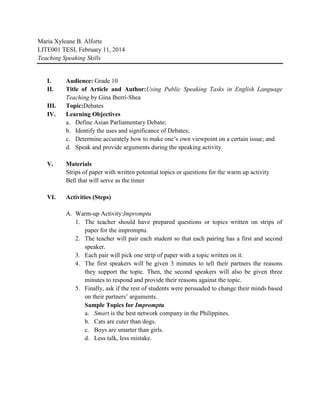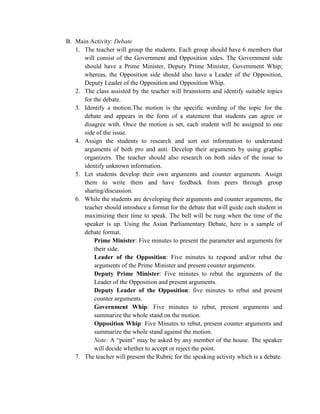Teaching Speaking skills
- 1. Maria Xyleane B. Alforte LITE001 TESL February 11, 2014 Teaching Speaking Skills I. Audience: Grade 10 II. Title of Article and Author:Using Public Speaking Tasks in English Language Teaching by Gina Iberri-Shea III. Topic:Debates IV. Learning Objectives a. Define Asian Parliamentary Debate; b. Identify the uses and significance of Debates; c. Determine accurately how to make oneâs own viewpoint on a certain issue; and d. Speak and provide arguments during the speaking activity. V. Materials Strips of paper with written potential topics or questions for the warm up activity Bell that will serve as the timer VI. Activities (Steps) A. Warm-up Activity:Impromptu 1. The teacher should have prepared questions or topics written on strips of paper for the impromptu. 2. The teacher will pair each student so that each pairing has a first and second speaker. 3. Each pair will pick one strip of paper with a topic written on it. 4. The first speakers will be given 3 minutes to tell their partners the reasons they support the topic. Then, the second speakers will also be given three minutes to respond and provide their reasons against the topic. 5. Finally, ask if the rest of students were persuaded to change their minds based on their partnersâ arguments. Sample Topics for Impromptu a. Smart is the best network company in the Philippines. b. Cats are cuter than dogs. c. Boys are smarter than girls. d. Less talk, less mistake.
- 2. B. Main Activity: Debate 1. The teacher will group the students. Each group should have 6 members that will consist of the Government and Opposition sides. The Government side should have a Prime Minister, Deputy Prime Minister, Government Whip; whereas, the Opposition side should also have a Leader of the Opposition, Deputy Leader of the Opposition and Opposition Whip. 2. The class assisted by the teacher will brainstorm and identify suitable topics for the debate. 3. Identify a motion.The motion is the specific wording of the topic for the debate and appears in the form of a statement that students can agree or disagree with. Once the motion is set, each student will be assigned to one side of the issue. 4. Assign the students to research and sort out information to understand arguments of both pro and anti. Develop their arguments by using graphic organizers. The teacher should also research on both sides of the issue to identify unknown information. 5. Let students develop their own arguments and counter arguments. Assign them to write them and have feedback from peers through group sharing/discussion. 6. While the students are developing their arguments and counter arguments, the teacher should introduce a format for the debate that will guide each student in maximizing their time to speak. The bell will be rung when the time of the speaker is up. Using the Asian Parliamentary Debate, here is a sample of debate format. Prime Minister: Five minutes to present the parameter and arguments for their side. Leader of the Opposition: Five minutes to respond and/or rebut the arguments of the Prime Minister and present counter arguments. Deputy Prime Minister: Five minutes to rebut the arguments of the Leader of the Opposition and present arguments. Deputy Leader of the Opposition: five minutes to rebut and present counter arguments. Government Whip: Five minutes to rebut, present arguments and summarize the whole stand on the motion. Opposition Whip: Five Minutes to rebut, present counter arguments and summarize the whole stand against the motion. Note: A âpointâ may be asked by any member of the house. The speaker will decide whether to accept or reject the point. 7. The teacher will present the Rubric for the speaking activity which is a debate.
- 3. Student Presentation Rubric (Debate) Criteria Points (1-5) Vocabulary The vocabulary is appropriate for the level. No errors in word choice and use. Intonation The pitch patterns and intonation are used accurately and effectively. Pace The speaker speaks at correct speed that is easier to understand and follow. Organization The speaker is well prepared in presenting arguments. Clarity of arguments Arguments are well presented and supported with evidence from researches and study. 8. Let the students review and reflect on the importance of debates. Then, the teacher will highlight that debates provide multiple sides to any issue. It helps people to look beyond their own beliefs and recognize their own stand or viewpoints. Source: Gina Iberri-Shea. (2009). Using Public Speaking Tasks in English Language Teaching. English Teaching Forum.Vol.47 , No.2, pp. 18-36



